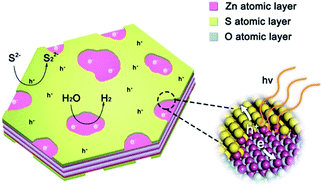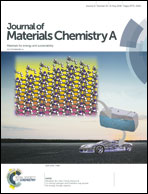ZnO nanosheets with atomically thin ZnS overlayers for photocatalytic water splitting†
Abstract
Zinc oxide is a cost-efficient and eco-friendly material for solar-to-chemical energy conversion. However, the relatively wide band gap and poor stability restrict its practical applications. Herein, we report on the modification of ZnO nanosheets with a porous atomically thin ZnS overlayer. The as-prepared ZnS/ZnO/ZnS sandwich nanosheets exhibit a reduced band gap (2.72 eV) and yet a slightly elevated conduction band minimum, which remarkably broadens the wavelength range for light absorption and generates electrons with enough reducing capability. At the same time, the newly-prepared sandwich nanosheets possess alternatively exposed ZnS and ZnO surface patches, which attract and accommodate photo-generated holes and electrons, respectively. In addition, the ZnS overlayer catalyzes and accelerates hole-consumption reactions, thus preserving electrons for efficient water splitting. As a result, the ZnS/ZnO/ZnS sandwich nanosheets demonstrate intensive light absorption, fast charge separation, long electron lifetime, and eventually the highest hydrogen production rate reported for oxide catalysts so far. This work proves that passivation with an ultrathin layer is a potent approach for energy-band engineering, and semiconductor sandwich nanostructures are promising for highly efficient water splitting under sunlight.



 Please wait while we load your content...
Please wait while we load your content...